| Listing 1 - 8 of 8 |
Sort by
|
Book
ISBN: 2870600690 9782870600696 Year: 1999 Volume: 10 Publisher: Bruxelles Ousia
Abstract | Keywords | Export | Availability | Bookmark
 Loading...
Loading...Choose an application
- Reference Manager
- EndNote
- RefWorks (Direct export to RefWorks)
L’auto-organisation est au cœur des principaux débats qui traversent aujourd’hui les sciences de la vie. Cet ouvrage tend tout d’abord à montrer la pertinence de ce concept et le caractère opératoire des modèles mathématiques qui lui sont liés dans de nombreux domaines scientifiques, de l’immunologie aux neurosciences en passant par l’écologie et les théories de l’évolution biologique. D’un point de vue historique, d’Aristote à Kant, le concept d’auto-organisation rejoint les intuitions des grands penseurs du vivant de la tradition occidentale. Les multiples enjeux de cette notion dans les sciences de la vie sont ainsi étudiés en un ouvrage qui met résolument en œuvre pratique interdisciplinaire et analyse critique, et éclaire un des débats théoriques les plus passionnants de notre temps.
Epistémologie --- Kennisleer --- Sciences --- Wetenschappen --- Biological systems --- Self-organizing systems --- Computational Biology --- Models, Biological --- Philosophy --- trends --- Biological systems. --- Self-organizing systems. --- Computational Biology - trends --- Biology --- Teleology. --- Philosophy. --- Émergentisme --- Sciences de la vie --- Systèmes auto-organisés
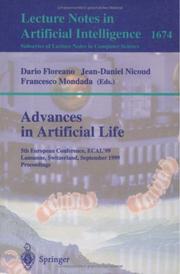
ISBN: 3540664521 3540483047 9783540664529 Year: 1999 Volume: 1674 Publisher: Berlin ; Heidelberg : Springer,
Abstract | Keywords | Export | Availability | Bookmark
 Loading...
Loading...Choose an application
- Reference Manager
- EndNote
- RefWorks (Direct export to RefWorks)
No matter what your perspective is, what your goals are, or how experienced you are, Artificial Life research is always a learning experience. The variety of phe nomena that the people who gathered in Lausanne reported and discussed for the fifth time since 1991 at the European Conference on Artificial Life (ECAL) has not been programmed, crafted, or assembled by analytic design. It has evolved, emerged, or appeared spontaneously from a process of artificial evolution, se- organisation, or development. Artificial Life is a field where biological and artificial sciences meet and blend together, where the dynamics of biological life are reproduced in the memory of computers, where machines evolve, behave, and communicate like living organ isms, where complex life-like entities are synthesised from electronic chromo somes and artificial chemistries. The impact of Artificial Life in science, phi losophy, and technology is tremendous. Over the years the synthetic approach has established itself as a powerful method for investigating several complex phenomena of life. From a philosophical standpoint, the notion of life and of in telligence is continuously reformulated in relation to the dynamics of the system under observation and to the embedding environment, no longer a privilege of carbon-based entities with brains and eyes. At the same time, the possibility of engineering machines and software with life-like properties such as evolvability, self-repair, and self-maintainance is gradually becoming reality, bringing new perspectives in engineering and applications.
Biological systems --- Robotics --- Artificial intelligence --- Computer simulation --- Simulation methods --- Computer science. --- Computers. --- Artificial intelligence. --- Bioinformatics. --- Computational biology. --- Robotics. --- Automation. --- Computer Science. --- Artificial Intelligence (incl. Robotics). --- Robotics and Automation. --- Computer Appl. in Life Sciences. --- Computation by Abstract Devices. --- Biology --- Artificial Intelligence. --- Data processing. --- Bioinformatics . --- Computational biology . --- AI (Artificial intelligence) --- Artificial thinking --- Electronic brains --- Intellectronics --- Intelligence, Artificial --- Intelligent machines --- Machine intelligence --- Thinking, Artificial --- Bionics --- Cognitive science --- Digital computer simulation --- Electronic data processing --- Logic machines --- Machine theory --- Self-organizing systems --- Fifth generation computers --- Neural computers --- Automatic computers --- Automatic data processors --- Computer hardware --- Computing machines (Computers) --- Electronic calculating-machines --- Electronic computers --- Hardware, Computer --- Computer systems --- Cybernetics --- Calculators --- Cyberspace --- Bioinformatics --- Bio-informatics --- Biological informatics --- Information science --- Computational biology --- Systems biology --- Automatic factories --- Automatic production --- Computer control --- Engineering cybernetics --- Factories --- Industrial engineering --- Mechanization --- Assembly-line methods --- Automatic control --- Automatic machinery --- CAD/CAM systems --- Automation --- Data processing --- Biological systems - Computer simulation - Congresses --- Biological systems - Simulation methods - Congresses --- Robotics - Congresses --- Artificial intelligence - Congresses
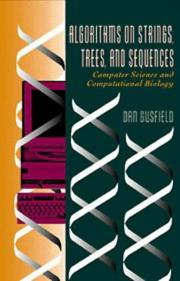
ISBN: 1107192145 1139811487 0511574932 1139811738 0511969651 1283870797 1139811606 9781139811736 9780511574931 0521585198 9780521585194 9781107192140 9781139811484 9780511969652 9781283870795 9781139811606 Year: 1999 Publisher: Cambridge Cambridge University press
Abstract | Keywords | Export | Availability | Bookmark
 Loading...
Loading...Choose an application
- Reference Manager
- EndNote
- RefWorks (Direct export to RefWorks)
String algorithms are a traditional area of study in computer science. In recent years their importance has grown dramatically with the huge increase of electronically stored text and of molecular sequence data (DNA or protein sequences) produced by various genome projects. This 1997 book is a general text on computer algorithms for string processing. In addition to pure computer science, the book contains extensive discussions on biological problems that are cast as string problems, and on methods developed to solve them. It emphasises the fundamental ideas and techniques central to today's applications. New approaches to this complex material simplify methods that up to now have been for the specialist alone. With over 400 exercises to reinforce the material and develop additional topics, the book is suitable as a text for graduate or advanced undergraduate students in computer science, computational biology, or bio-informatics. Its discussion of current algorithms and techniques also makes it a reference for professionals.
Computer algorithms. --- Computational biology. --- Molecular biology --- Molecular biochemistry --- Molecular biophysics --- Biochemistry --- Biophysics --- Biomolecules --- Systems biology --- Biology --- Bioinformatics --- Algorithms --- Data processing. --- Computational biology --- Computer algorithms --- Data processing --- 681.3*F2 --- 681.3*F2 Analysis of algorithms and problem complexity--See also {681.3*B6}; {681.3*B7}; {681.3*F13} --- Analysis of algorithms and problem complexity--See also {681.3*B6}; {681.3*B7}; {681.3*F13} --- Algorithms. --- Sequence Analysis. --- Molecular Biology. --- Electronic Data Processing. --- Algorithmes --- Biologie moléculaire --- Informatique --- Discrete mathematics --- Computer science --- Programming --- algoritmen --- Molecular biology - Data processing.
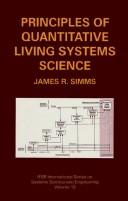
ISBN: 1280205377 9780306469669 9786610205370 0306469669 0306459795 Year: 1999 Publisher: New York, New York State : Plenum Publishers,
Abstract | Keywords | Export | Availability | Bookmark
 Loading...
Loading...Choose an application
- Reference Manager
- EndNote
- RefWorks (Direct export to RefWorks)
In 1978, when the book Living Systems was published, it contained the prediction that the sciences that were concerned with the biological and social sciences would, in the future, be stated as rigorously as the “hard sciences” that study such nonliving phenomena as temperature, distance, and the interaction of chemical elements. Principles of Quantitative Living Systems Science, the first of a planned series of three books, begins an attempt to fulfill that prediction. The view that living things are similar to other parts of the physical world, differing only in their complexity, was explicitly stated in the early years of the twentieth century by the biologist Ludwig von Bertalanffy. His ideas could not be published until the end of the war in Europe in the 1940's. Von Bertalanffy was strongly opposed to vitalism, the theory current among biologists at the time that life could only be explained by recourse to a “vital principle” or God. He considered living things to be a part of the natural order, “systems” like atoms and molecules and planetary systems. Systems were described as being made up of a number of interrelated and interdependent parts, but because of the interrelations, the total system became more than the sum of those parts. These ideas led to the development of systems movements, in both Europe and the United States, that included not only biologists but scientists in other fields as well. Systems societies were formed on both continents.
Biological systems. --- System theory. --- Animal behavior. --- Systems theory. --- Systems Theory, Control. --- Mathematical and Computational Biology. --- Biomathematics. --- Biology --- Mathematics --- Systems, Theory of --- Systems science --- Science --- Philosophy --- Animals --- Animals, Habits and behavior of --- Behavior, Animal --- Ethology --- Animal psychology --- Zoology --- Ethologists --- Psychology, Comparative --- Biosystems --- Systems, Biological --- System theory --- Systems biology --- Behavior
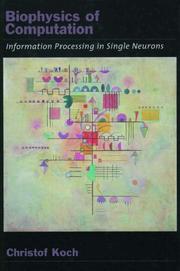
ISBN: 0197562337 1280595094 9786613624925 0199760551 9780199760558 0195104919 9780195104912 0195181999 9780195181999 9781280595097 6613624926 0190292857 9780197562338 Year: 1999 Publisher: New York (N.Y.) Oxford university press
Abstract | Keywords | Export | Availability | Bookmark
 Loading...
Loading...Choose an application
- Reference Manager
- EndNote
- RefWorks (Direct export to RefWorks)
In this volume, Koch shows how individual nerve cells can multiply, integrate, or delay synaptic inputs, and how information is encoded in the voltage across the membrane, in the intracellular calcium concentration, or in the timing of individual spikes.
Computational neuroscience. --- Neurons. --- Neural networks (Neurobiology) --- Action potentials (Electrophysiology) --- Neural conduction. --- Conduction, Neural --- Nerve conduction --- Neurophysiology --- Electrophysiology --- Biological neural networks --- Nets, Neural (Neurobiology) --- Networks, Neural (Neurobiology) --- Neural nets (Neurobiology) --- Cognitive neuroscience --- Neurobiology --- Neural circuitry --- Nerve cells --- Neurocytes --- Cells --- Nervous system --- Computational neurosciences --- Computational biology --- Neurosciences --- Computational neuroscience --- Neural conduction --- Neurons
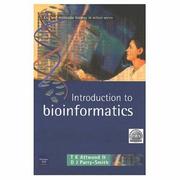
ISBN: 0582327881 9780582327887 Year: 1999 Publisher: Harlow Prentice Hall
Abstract | Keywords | Export | Availability | Bookmark
 Loading...
Loading...Choose an application
- Reference Manager
- EndNote
- RefWorks (Direct export to RefWorks)
The book provides an undergraduate (final year) introduction to bioinformatics focussing on two key areas, genomics and protein sequence analysis. It provides an overview of primary, composite and secondary databases, and gives a brief introduction to the Internet and the world wide web.
Molecular biology --- Computer. Automation --- Bioinformatics --- Bio-informatique --- Biologie moléculaire --- Data processing --- Informatique --- Gene mapping --- Data processing. --- Biologie moléculaire --- Basic Sciences. Bioinformatics -- Bioinformatics (General) --- ALLW. --- 57.087 --- 57.087 Methods and techniques for parameter estimation. Recording of biological data --- Methods and techniques for parameter estimation. Recording of biological data --- Molecular biochemistry --- Molecular biophysics --- Biochemistry --- Biophysics --- Biomolecules --- Systems biology --- Molecular biology - Data processing. --- Gene mapping - Data processing. --- Basic Sciences. Bioinformatics -- Bioinformatics (General). --- Computational Biology
Periodical
ISSN: 14645238 14639238 Year: 1999 Publisher: [New York] : Taylor and Frances,
Abstract | Keywords | Export | Availability | Bookmark
 Loading...
Loading...Choose an application
- Reference Manager
- EndNote
- RefWorks (Direct export to RefWorks)
Medical Informatics --- Internet --- Automatic Data Processing --- Medical informatics --- Information storage and retrieval systems --- Medical Informatics. --- Internet. --- Automatic Data Processing. --- Medical informatics. --- Medicine --- Medicine. --- Geneeskunde. --- Informatica. --- Clinical informatics --- Health informatics --- Medical information science --- DARPA Internet --- Internet (Computer network) --- World Wide Web --- Internets --- Web, World Wide --- Wide Web, World --- Information Processing --- Bar Codes --- Computer Data Processing --- Data Processing, Automatic --- Electronic Data Processing --- Information Processing, Automatic --- Optical Readers --- Automatic Information Processing --- Bar Code --- Code, Bar --- Codes, Bar --- Data Processing, Computer --- Data Processing, Electronic --- Optical Reader --- Processing, Automatic Data --- Processing, Automatic Information --- Processing, Computer Data --- Processing, Electronic Data --- Processing, Information --- Reader, Optical --- Readers, Optical --- Computer Science, Medical --- Health Information Technology --- Informatics, Clinical --- Informatics, Medical --- Information Science, Medical --- Clinical Informatics --- Medical Computer Science --- Medical Information Science --- Health Information Technologies --- Information Technologies, Health --- Information Technology, Health --- Medical Computer Sciences --- Medical Information Sciences --- Science, Medical Computer --- Technologies, Health Information --- Technology, Health Information --- Automatic data storage --- Automatic information retrieval --- Automation in documentation --- Computer-based information systems --- Data processing systems --- Data storage and retrieval systems --- Discovery systems, Information --- Information discovery systems --- Information processing systems --- Information retrieval systems --- Machine data storage and retrieval --- Mechanized information storage and retrieval systems --- Information science --- Wide area networks (Computer networks) --- Cyber Space --- Cyberspace --- Computers --- Health Informatics --- Informatics, Health --- Computational Biology --- Biomedical Technology --- American Recovery and Reinvestment Act --- Computer systems --- Electronic information resources --- Data libraries --- Digital libraries --- Information organization --- Information retrieval --- Data processing --- Electronic Data Processing. --- Data centers
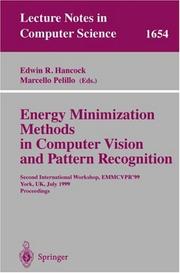
ISBN: 3540484329 3540662944 Year: 1999 Publisher: Berlin ; Heidelberg : Springer Verlag,
Abstract | Keywords | Export | Availability | Bookmark
 Loading...
Loading...Choose an application
- Reference Manager
- EndNote
- RefWorks (Direct export to RefWorks)
Computer vision --- Pattern recognition systems --- Neural networks (Computer science) --- Evolutionary computation --- Simulated annealing (Mathematics) --- Applied Physics --- Engineering & Applied Sciences --- Algorithm, Annealing --- Algorithm, Probabilistic exchange --- Annealing, Monte Carlo --- Annealing, Simulated --- Annealing algorithm --- Cooling, Statistical --- Exchange algorithm, Probabilistic --- Hill climbing, Probabilistic --- Monte Carlo annealing --- Probabilistic exchange algorithm --- Probabilistic hill climbing --- Relaxation, Stochastic --- Statistical cooling --- Stochastic relaxation --- Computer science. --- Computer logic. --- Image processing. --- Pattern recognition. --- Biomathematics. --- Statistical physics. --- Dynamical systems. --- Computer Science. --- Pattern Recognition. --- Image Processing and Computer Vision. --- Logics and Meanings of Programs. --- Statistical Physics, Dynamical Systems and Complexity. --- Mathematical and Computational Biology. --- Combinatorial optimization --- Optical pattern recognition. --- Computer vision. --- Logic design. --- Complex Systems. --- Statistical Physics and Dynamical Systems. --- Physics --- Mathematical statistics --- Design, Logic --- Design of logic systems --- Digital electronics --- Electronic circuit design --- Logic circuits --- Machine theory --- Switching theory --- Machine vision --- Vision, Computer --- Artificial intelligence --- Image processing --- Optical data processing --- Pattern perception --- Perceptrons --- Visual discrimination --- Statistical methods --- Optical data processing. --- Computer science logic --- Logic, Symbolic and mathematical --- Optical computing --- Visual data processing --- Bionics --- Electronic data processing --- Integrated optics --- Photonics --- Computers --- Design perception --- Pattern recognition --- Form perception --- Perception --- Figure-ground perception --- Biology --- Mathematics --- Dynamical systems --- Kinetics --- Mechanics, Analytic --- Force and energy --- Mechanics --- Statics --- Optical equipment
| Listing 1 - 8 of 8 |
Sort by
|

 Search
Search Feedback
Feedback About UniCat
About UniCat  Help
Help News
News